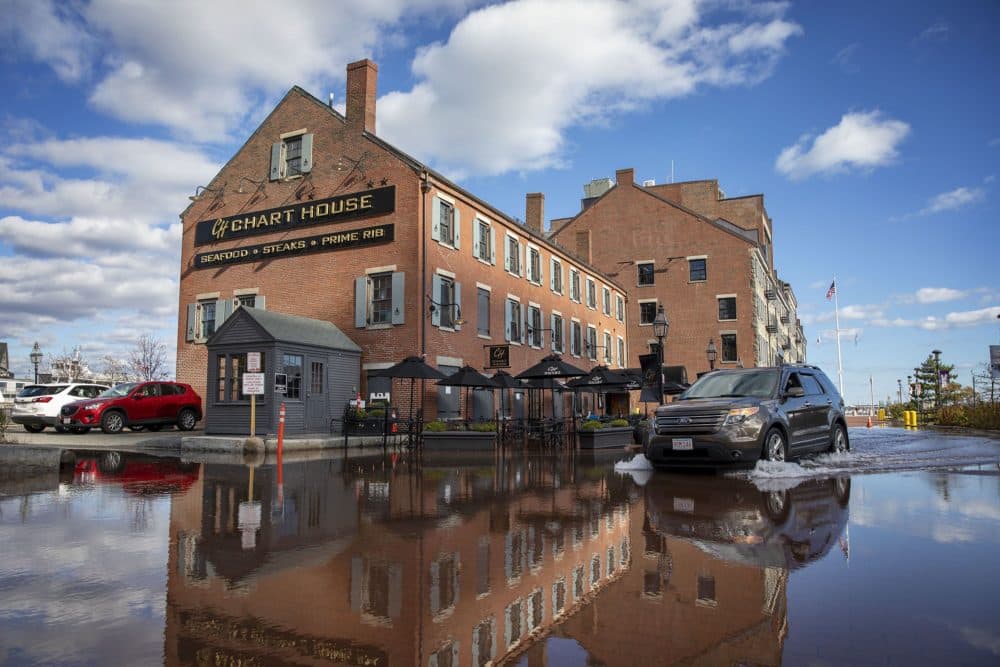Increased coastal flooding due to climate change threatens hundreds of potentially toxic sites like power plants and sewage treatment facilities in New England, according to a new study.
The research found that under current global commitments to reduce climate pollution, more than 400 sites with hazardous materials in New England — and about 5,100 others across the country — are at risk for a significant flood event by the end of the century.
Those events are sometimes referred to as “100-year floods” because they have a 1-in-100 chance of occurring in any given year.
Researchers at the University of California, Los Angeles; the University of California, Berkeley; Nanjing University; and the nonprofit Climate Central contributed to the study, which published Thursday in the journal Nature Communications.
The analysis also found that flood risk disproportionately affects some communities, including those with higher proportions of low-income and elderly residents and people whose first language is not English. Such groups are more likely to live near industrial sites, where floodwaters can mix with toxic chemicals, sewage and other substances that can cause health risks.
“The fact that socially marginalized and more vulnerable communities are disproportionately likely to live near such a site speaks to the importance of planning ahead,” said Lara Cushing, an associate professor at the University of California, Los Angeles, and the study’s lead author.
Neighborhoods near at-risk facilities also tended to have higher proportions of renters, non-voters and households without a vehicle, the researchers found.
“We’re all exposed to climate change, but we’re not all equally vulnerable,” said Marcos Luna, a Salem State University professor who was not involved in the study.
 A car drives through flood water by the Chart House on Boston’s Long Wharf during a November king tide. (Robin Lubbock/WBUR)
A car drives through flood water by the Chart House on Boston’s Long Wharf during a November king tide. (Robin Lubbock/WBUR)
The researchers analyzed federal data on toxic sites and flood projections across the country under different scenarios of greenhouse gas emissions. They also looked at census and voter turnout data.
Their findings suggest that nearly 80% of at-risk facilities are located in just seven states, including Massachusetts.
In New England, the majority of sites are located in Massachusetts, followed by Connecticut, Rhode Island, Maine and New Hampshire. More than half the sites in the region are industrial facilities.
Of Massachusetts’ 209 at-risk sites, most are concentrated around Boston Harbor. The riskiest ones — sites that could experience more than 12 days of nearby high water levels by the end of the century — include a machinery company, Boston Ship Repair, and the sewage treatment plant at Columbus Park.
Other sites in Massachusetts include some storing dangerous chemicals that WBUR previously reported as vulnerable to storm surge. These include Kettle Cuisine, a wholesale food company in Lynn, and Twin Rivers Technologies in Quincy.
The study looked at the likelihood of flood events under different emissions scenarios and found that if climate pollution went unchecked, the number of estimated 100-year flood events would double for some New England facilities.
Even in the best case scenario of current global emissions goals, Cushing said the region will see some impacts from flooding and sea level rise.
“Aggressively reducing our greenhouse gas emissions is still important if you want to slow sea level rise. But in the near-term, this is definitely coming no matter what we do,” Cushing said.
The researchers developed a tool using data from the study that allows people to search for sites in their cities, as well as demographic information for nearby neighborhoods.
The tool could help local governments improve their disaster preparedness plans, and address some historical inequities, said Luna, the researcher at Salem State. For example, more than half of homes in the neighborhood near the Columbus Park sewage treatment plant don’t have a car, according to the data.
“If there has to be an evacuation, that’s a really big question, particularly for Boston because there’s only a few routes away from the coastline,” Luna said. “Climate change exacerbates a lot of these existing problems.”
 A man takes photographs as floodwaters surge at Boston’s Long Wharf in 2018. (Robin Lubbock/WBUR)
A man takes photographs as floodwaters surge at Boston’s Long Wharf in 2018. (Robin Lubbock/WBUR)
Researchers said they worry that some of the federal data used for this study is no longer being updated or faces an uncertain future under the Trump administration. Federal officials have said tools intended to address inequities in environmental harms are discriminatory. And the Environmental Protection Agency wants to repeal a finding that climate change endangers people.
“ We are definitely witnessing the dismantlement and the disappearance of really important data,” said Rachel Morello-Frosch, a study co-author and professor at U.C. Berkeley.
That disappearance will make it harder to tell where the problems are in a warming world, said Darya Minovi, a senior analyst at the Cambridge-based Union for Concerned Scientists, a group that has studied the threat of extreme weather to chemical sites, but was not involved in this study.
“The consequences of the lack of federal investment are just going to continue playing out over the coming years, and we’re not really going to know the scope of it for months and years to come,” she said.
